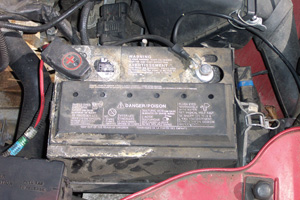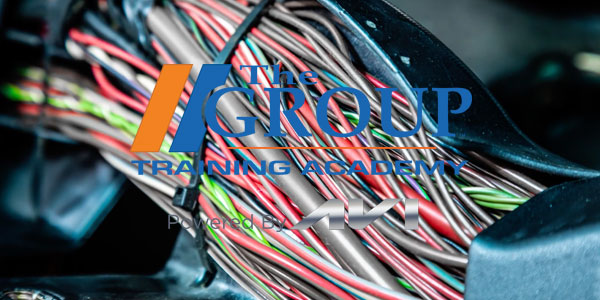● BATTERY — Provides current for cranking the engine, and to supplement the electrical needs of the vehicle. Automotive 12-volt batteries are usually located in the engine compartment, but some may be mounted elsewhere (under back seat, in the trunk, behind the inner fender splash guard, etc.). Most are maintenance-free and require no make-up water to be added during the service life of the battery.
 Most automotive batteries are lead-acid batteries with six cells and are rated at 12 volts (actually 12.66 volts when fully charged). Conventional batteries are filled with a liquid acid electrolyte, but some use a “gel” electrolyte or “Absorbent Glass Mat” (AGM) with a paste electrolyte that is leak-proof. Most batteries have flat cell plates but some AGM batteries have spiral wound cylindrical cells that resemble a six-pack. Most hybrid vehicles currently use high-voltage (up to 300 volts) nickel metal hydride (NMH) batteries, and also have a conventional 12-volt lead-acid battery for accessory functions.
Most automotive batteries are lead-acid batteries with six cells and are rated at 12 volts (actually 12.66 volts when fully charged). Conventional batteries are filled with a liquid acid electrolyte, but some use a “gel” electrolyte or “Absorbent Glass Mat” (AGM) with a paste electrolyte that is leak-proof. Most batteries have flat cell plates but some AGM batteries have spiral wound cylindrical cells that resemble a six-pack. Most hybrid vehicles currently use high-voltage (up to 300 volts) nickel metal hydride (NMH) batteries, and also have a conventional 12-volt lead-acid battery for accessory functions.
Batteries come in many different “group” sizes, which depend on the length, width and height of the battery, plus the post configuration (top or side posts). GM vehicles mostly use side-post batteries. A replacement battery must be a compatible group size to physically fit the battery tray. Some aftermarket batteries are designed with both types of post configurations to fit a variety of applications.
The “Cold Cranking Amp” (CCA) capacity of batteries also vary according to application. The higher the CCA rating, the more cranking amperage the battery can provide for reliable cold starting. The “Reserve Capacity” (RC) rating is how many amp hours of operation the battery can provide should the charging system fail. A replacement battery should have CCA and RC that meets or exceeds the OEM battery requirements.
All batteries have a number/letter date code that indicates when the battery was manufactured. The number indicates the year, and the letter corresponds to the month (A = January, B = February, C = March, etc.). Fresher is better. Batteries should be stocked so the oldest are sold first and the newest are sold last. Battery charge also should be checked when a battery is sold to make sure it is 100 percent.
Batteries should be replaced when they can no longer hold a charge or fail a load test or capacitance test. Average battery life is typically 3 to five years. Used batteries should always be recycled. Handle all batteries with care to prevent acid burns.
Replacement battery trays and holddowns are also available for corroded or missing parts. A firm battery mounting is necessary to hold the battery in place and to minimize shaking or jolts that could cause internal battery damage.
● BATTERY CABLES — Connect the battery to the vehicle’s electrical system. The positive cable typically connects the battery positive (+) post to the starter solenoid or relay. The negative cable connects the battery negative (-) post to the engine and/or chassis ground. Positive cables may be color-coded red, and ground cables color-coded black. Most vehicles also have ground straps that provide an additional electrical connection between the engine and body. A loose or corroded battery cable can prevent an engine from cranking and/or prevent the charging system from keeping the battery charged. Replacement ends are available for damaged battery cables, but the best fix is to replace the entire cable to assure the best possible electrical connection. Recommend using a battery post cleaning tool when replacing batteries or cables.
● ALTERNATOR — The main component in the charging system. The alternator produces current to maintain the battery at full charge and to provide all or most of the amperage needed by the ignition system, engine, lights and electrical accessories. Alternators produce alternating current (AC), which is converted to direct current (DC) by a diode trio (rectifier) on the back of the unit.
Mounted on the engine and driven by a belt, the alternator’s output increases in proportion to the electrical loads placed on the charging system. Charging output is controlled by a voltage regulator or the powertrain control module (PCM). Alternators have different amperage output ratings, so an alternator should be replaced if its charging output is less than specifications.
A symptom of a bad alternator is a dead battery, a charging or alternator warning lamp, or dim headlights. Alternators have a high warranty return rate due to misdiagnosis, so bench testing the old unit is recommended to confirm an alternator needs to be replaced.
A replacement alternator (new or reman) should have the same or higher amp rating as the original. Special “high output” alternators are an upgrade option for applications with high electrical demands such as police vehicles and those with high-wattage sound systems.
● ALTERNATOR PULLEY — If a replacement alternator comes with a pulley (some do not), make sure it matches the original (same diameter, width and belt type). Some late model alternators are factory-equipped with overrunning alternator decoupler (OAD) pulleys that reduce noise, vibration and harshness. Replacement pulleys on these applications must use an OAD pulley.
● VOLTAGE REGULATOR — Controls the amperage output of the alternator by sensing the electrical load on the charging system. Most newer vehicles either have an internal regulator mounted inside the alternator (which cannot be replaced separately), or use the powertrain control module (PCM) to regulate the charging system. Some older vehicles have an external regulator (mechanical or electronic) that can be replaced if it causes a charging problem.
● STARTER — An electric motor mounted on the engine or transmission that cranks the engine to start it. There are several different types: direct drive starter motors, gear reduction starter motors and permanent magnet starter motors (reduced size starters with permanent magnets inside instead of wire coils).
When the engine is cranked, the starter drive engages the flywheel. When the engine starts and the driver releases the ignition key, the starter drive should retract. A one-way overrunning clutch is used to protect most starters against damage should the starter remain engaged after the engine starts.
Because of the high load on the starter, good electrical connections are extremely important. Loose, corroded or undersized battery cables may not deliver enough amperage to crank the engine at normal speed, causing hard starting. Starter drives (which can be replaced separately on many starters) can also fail, preventing the motor from engaging the flywheel. A bad solenoid or relay will prevent the starter motor from cranking at all. Accurate diagnosis of a starter problem is important to prevent unnecessary parts replacements and returns.
Ignition System
Manual Transmission/Transaxle Parts
Emission Controls
Driveline Components











